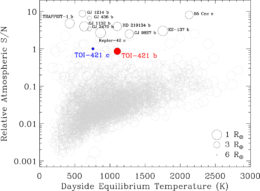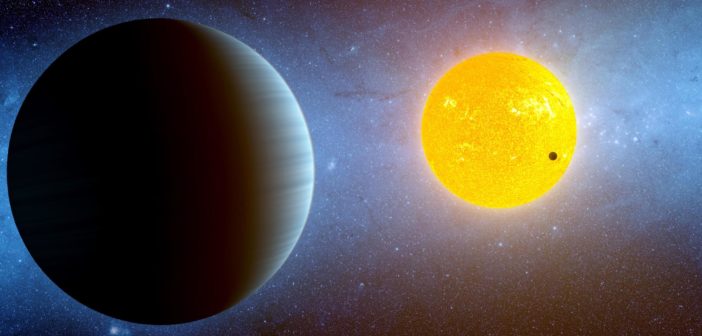Less than 250 light-years from Earth lie two newly found planets orbiting a star not unlike our own. A new study introduces these discoveries and explores what we may learn from future observations of their puffy atmospheres.
Identifying Ideal Targets
The Transiting Exoplanet Survey Satellite (TESS) mission was specifically designed to search for transiting planets smaller than 4 Earth radii around bright stars — and it’s already found more than 1,000 planet candidates, with 10,000 expected by mission end. These discoveries will help us to better understand the transition between rocky planets like Earth, which have compact atmospheres, and gaseous sub-Neptunes, which have extended, puffy atmospheres.With the upcoming launch of the James Webb Space Telescope (JWST), we’d especially like to identify TESS discoveries that make ideal candidates for transit spectroscopy with JWST. Transit spectroscopy allows us to study the atmospheres of nearby planets as they orbit across the face of their bright host star.

TESS light curves showing the phase-folded transits for TOI-421 b (top) and c (bottom). [Adapted from Carleo et al. 2020]
A Pair of Puffy Planets
We find planets all the time — so what makes TOI-421 b and c worth talking about? Carleo and collaborators’ detailed characterization of the planets shows intriguing properties that could help us learn more about the transition between rocky Earths and gaseous Neptunes.
The inner planet, TOI-421 b, has a low density that’s similar to that of Neptune — despite the fact that the planet’s mass is less than half of Neptune’s. Using atmospheric loss models, Carleo and collaborators demonstrate that this puzzling planet — which lies on a blistering 5-day orbit very close to its toasty host star — should have lost all of its hydrogen-dominated atmosphere early in its lifetime. In spite of this, the TOI-421 b’s low bulk density strongly points to the presence of a puffy hydrogen atmosphere. More study will clearly be needed to better understand what we’re missing about this mysterious planet.

TOI-421 b and c lie among the 30 most favorable targets for atmospheric characterization, based on their predicted signal to noise with future observations. Click to enlarge. [Carleo et al. 2020]
Carleo and collaborators’ models suggest that these planets’ extended atmospheres can be probed with ultraviolet observations like those from Hubble; the authors also provide detailed predictions of what we expect to find in the transmission spectra of the two planets from JWST.
Comparison of these predictions to future observations of the TOI-421 system is sure to provide valuable insight from these intriguing, puffy planets.
Citation
“The Multiplanet System TOI-421,” Ilaria Carleo et al 2020 AJ 160 114. doi:10.3847/1538-3881/aba124



3 Comments
Pingback: From AAS NOVA: “Opportunities from a Newly Discovered Planetary System” | sciencesprings
Pingback: Możliwości wynikające z nowo odkrytego układu planetarnego – PTMA Kraków
Pingback: Możliwości wynikające z nowo odkrytego układu planetarnego – Astronomia Śląska